As most of my regular readers may have noticed (and I’ve seen questions about this!) that most all hydroponic systems are for growing vegetables for their tops, like herbs, salad greens, tomatoes, etc. So what if you want to grow potatoes, carrots, onions or other root vegetables? I have now researched this and come up with solutions on how to grow root vegetables indoors.
How to Grow Root Vegetables Indoors with Soil – Potatoes
This basically comes down to whether you wish to use soil or hydroponics. In this case, I am thinking that the hydroponic option is actually the more difficult of the two although it does have its advantages.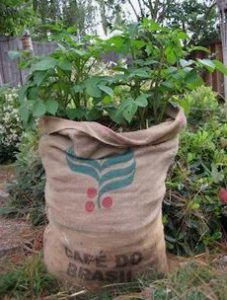
Potatoes need a lot of space so for these you would want a 5 – 10-gallon container. You will be able to get a far greater yield than with a smaller container. Chit your potatoes by leaving them in natural light to sprout. It is best to use seed potatoes purchased from a garden shop as store-bought potatoes often have insecticides and such sprayed on them. Having said that, I would still probably try to grow some of those potatoes that end up growing in the bottom of the bag from the store. You can cut the potatoes up – just make sure there is at least one growing eye and a good size chunk of potato on each piece. Sprouting needs to have happened for the potato to successfully produce more potatoes.
What to Grow Them In?
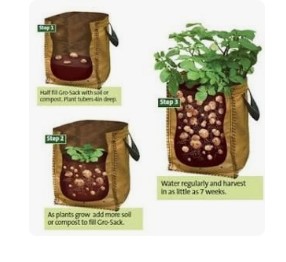 You can use any kind of tall plastic, food-grade container or even bags, such as old fertilizer bags. Use good quality potting soil. Put a few inches of soil in the bottom of your container and place your potatoes with the sprouting eyes turned upwards. Cover with a few inches of soil and water. This should leave plenty of your container above the potatoes with nothing in it. This is what we want. If you are using a fertilizer bag, just roll down the edges to make it more manageable at this stage.
You can use any kind of tall plastic, food-grade container or even bags, such as old fertilizer bags. Use good quality potting soil. Put a few inches of soil in the bottom of your container and place your potatoes with the sprouting eyes turned upwards. Cover with a few inches of soil and water. This should leave plenty of your container above the potatoes with nothing in it. This is what we want. If you are using a fertilizer bag, just roll down the edges to make it more manageable at this stage.
Watering and Maintenance
When watering, you want the soil moist but with no pooling of water at the bottom of the container as this will cause the potatoes to rot. Once you get 4-5 inches of top growth, start adding more soil so that at any time, there is only a few inches of green growth showing at the top. Keep doing this as the plants grow until your container or bag is full. The potatoes will grow from the stem of the potatoes that have grown up through the soil and you will have a bountiful harvest. Water about every third day, ensuring that you water enough to dampen the soil all the way to the bottom. The soil should be moist but not wet.
Planting
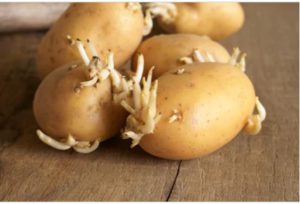
The indoor potato planting process is simple, but your potatoes will need some maintenance throughout their growth cycle to ensure a high yield and healthy spuds. First, find a good, natural light source in your home to ensure about 14 hours of light per day, or use LED lights if growing all year round. Potatoes need to be kept at room temperature. During the winter, this temperature might drop a bit so you will want to keep them near a heat source but not overheated.
Once your plants have gained full maturity, they will begin to turn yellow and are usually ready for harvesting. At this point, stop watering them so that the potatoes harden off and develop a decent skin on them. Wait until the plants die off completely to ensure the maximum growth of the spuds. Double-check a potato or two for maturity by rubbing your thumb gently against the skin. If it stays in place, it’s ready to harvest.
How to Grow Root Vegetables Indoors with Soil – Other Veggies
You still want tall buckets or bags but you probably only need 3-gallon size, depending on what you are growing. Daikon can grow 16-18″ whereas carrots, onions, radishes, etc are shorter. Choose your container or bag to suit the length of the vegetable you plan on growing. Fill the container with potting soil, sow your seed or bulbs as per normal and water.
Growing Root Vegetables Hydroponically
The best hydroponic system for potatoes is one that uses a supportive medium for the plants to grow in and does not require that the potatoes be submerged or kept continually wet. A very simple hydroponic system for growing potatoes can be made easily from a plastic container such as a storage bin or large bucket with 1/4-inch-diameter holes drilled in its sides about 2 inches up from its bottom and spaced a few inches apart all the way around the container. The bin must be at least 2 feet deep and filled with perlite.
Follow the same instructions as if planting in soil with planting potatoes near the bottom and gradually filling the container only this tine use perlite rather than soil. Potato plants need access to plenty of water, but they can’t be kept overly wet or they will rot before they have a chance to grow. Fill the container with water until the perlite or other medium is soaked and water begins to run out the holes. Having a plastic tray under the container will catch any runoff.
Watering
Use ordinary tap water to water the seed potatoes every three to five days, preventing the perlite from drying out. When they have sprouted, continue watering as before but alternate between plain water and a fertilizer mixture made by adding 1 teaspoon of 20-20-20, water-soluble fertilizer that includes micronutrients to 1 gallon of water. When the plants’ vines are roughly 18 inches in height, switch to a fertilizer that has more potassium than other elements, such as a 10-10-20 blend, which will boost the development of the tubers. Harvest mature tubers about three weeks after the vines die, and/or harvest small, tender tubers as soon as 70 days after planting. This harvest time should be about a month earlier than for those veggies grown in soil.
Other root vegetables can be sown directly into perlite as well such as onions or garlic but if you are dealing with tiny seeds, you may want to start them in rockwool cubes first so that they don’t wash down to the bottom of the container and get lost.
Please note that this site is supported by affiliate marketing which means that a small portion will be paid to maintain this site from any purchases made through it. This in no way affects the price of the products on this page.
TQQFUN 2 Pack 7 Gallon Smart Potato Bags Velcro Window Vegetable Bags, Double Layer Premium Breathable Nonwoven Cloth for Potato/Aeration Fabric Pots with Handles(Gray)

- Unique Design: The TQQFUN each Potato bag with a visualization window.
- Easy to Move: Has a firm handle that allows you to move it easily. TQQFUN potato bags are perfect for patios, small gardens, balconies, sunrooms, and any indoor/outdoor space. They can be used for potatoes, onions, taro, radish, carrots, and other vegetables.
- Durable material and Reusable: Made of breathable fabric, which is environmentally friendly. Lightweight and rugged, reusable for years. It can be folded and stored during idle. It also is used as a storage bag, such as put dirty clothes, pack the tools in, etc.
- Healthy: Breathable, flexible fabric.
- 100% Customer Satisfaction Guarantee.
Click HERE to view on Amazon.
Darlene’s Opinion: These are inexpensive and could be used with either soil or perlite. The breathable fabric lets the maximum amount of air in as possible for healthy roots.
WINNER OUTFITTERS 6-Pack 10 Gallon Grow Bags/Aeration Fabric Pots with Handles
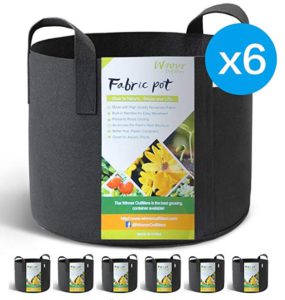
- Material: Made with high-quality nonwoven fabric, Built-in handles for easy movement
- Structure: Prevents roots circling and air-prunes plant’s root structure, so it’s better than Plastic Containers
- Warmer & Cooler: Keeps plant warmer in winter and cooler in the summer
- Package: 6-pack 10 gallon grow bags
- Their guarantee: “If you don’t like our grow bags, or whatever, we’ll instantly refund your money and you can keep the grow bags, no questions asked. It’s our promise and we don’t lie.”
Click HERE to view on Amazon.
Darlene’s Opinion: These are as good as the ones above and can also be used with soil or perlite. The felt fabric prevents root circling and they are larger.
Now, for those of you who do not want to hand water I am including the following:
HydroLock All in One Professional Grow Kit – Includes Drip Irrigation Emitters, Pump, Hydrolock Water Distributing Caps, Fittings, Bubbler Manifold, Tubing. Indoor & Outdoor Use – USA Made (12-Plant)
Click HERE to see on Amazon.
Darlene’s Opinion: This is your drip irrigation in case you don’t want to be locked into trying to remember to water your plants. This will fully automate your system. I would highly recommend buying a timer so that your veggies will never be too dry or too wet. You will also need to buy a reservoir with this. The usual opaque Rubbermaid (or other brands) container with a hole drilled in the top will work just fine.
Conclusion – How to Grow Root Vegetables Indoors
Now you can grow all of your vegetables all year round. The bags from Amazon could be used for large plants like tomatoes as well as small trees. Check out my other blogs and there will be nothing you can’t grow right in the comfort of your own home! Next week, watch for a series of blogs on lighting! As always, please feel do comment on this blog – it gives me new ideas on what to write about! Got a friend that might be interested in this? Please share widely!
Related Posts
Can You Profit From Hydroponics?
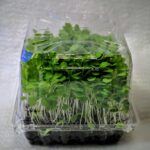

5 (8) Did you hear the story of a farmer who started growing strawberries? Yes? But, do you know he…
Conventional vs. Organic Hydroponic Nutrients


0 (0) Are “Organic” nutrients really better for your system or for your customers? Find out in this video from…
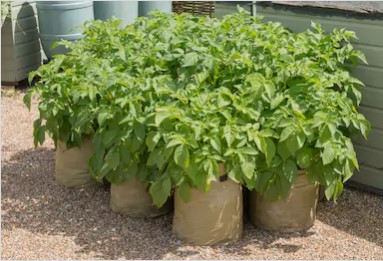


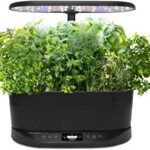

This is great and I was starting to wonder how I was going to keep growing things now that the Autumn weather is on the way. Potatoes are great with almost any main course, so that seems like the perfect place to start growing indoors. I’m looking forward to your next detailed post about lighting systems… I think I’ll need to add that to really make sure that I get enough crop yield.
Thank you, Aly! And don’t forget about the beets, onions, garlic and other root veggies! We can do them all!
These days there are so many creative and innovative containers for plants and for root crops, in particular, the bags and that be reused later is the best one and it goes with many bags according to the requirement and plans we wanted to grow in our own terrace-like I am staying in a high rise condo in one of my homes. The best ways to plant are those root crops that are common where you live. And according to the season and temperature. Root crops like carrots, turnips, radish, potatoes, beetroots are my favorites. Good info and good products. I wanted to have at least ten 6-Pack 10 Gallon Grow Bags/Aeration Fabric Pots with Handles.
Thank you so much and I think that would be the perfect one for you to buy. That way you can plant a different veggie in each bag and have an entire winter’s worth of root crops. Best of luck!
I think I may have just realized why I haven’t been successful at growing potatoes! You mentioned placing the sprouting eyes facing upward. I don’t think I’ve ever paid much attention to to the direction of the eyes! (This AND perhaps I watered them too often!) Poor things never had a chance! Your post offers great advice. Thank you for sharing your knowledge! I can’t wait to read about your suggestions on lighting!
Thank you so much and I’m so glad this helped. I have a friend who planted an entire row of onions upside down so don’t feel TOO bad! LOL
Oh yes, this is a thing. My mum has blhad the thought of growing potatoes indoor vjt once she couldn’t get resources on how to do that, she dropped the idea totally, I’m glad you could come up with a solution here. I’m sure she’s going to like this and you have also added that we can buy bags from amazon. Maybe she will try out the other roof plants too. Thanks for this educative post. I’ll expect more.
Thank you, Henderson! This actually took a whole lot more research than most of my other blogs. You’re right, there aren’t many solutions out there for root veggies growing indoors but I was bound and determined that there HAD to be a way!
Hello Darlene, I must say you have made a mark on my heart for putting up this post. For quite some time now I’ve been meaning to plant some of my stuffs on my own, here in my compound but several trials, same number of fails. I am very excited to have come across this post, I have learned better ways of dealing with my planting indoor. Also the suggestion of bag which can be used. Thanks for sharing
Hi Cloe. I can sure understand that space can be an issue but with these bags it makes growing easy and compact. I hope you enjoy your growing experience!
Ohho! This is massive and also coincidental. My sister and I both work as gardener, though separately but then, we do share ideas well and she asked me to ask you concerning growing of non vegetables indoors using hydroponics. This is great and I believe it has covered every area she might want to seek clarification on. Thanks for sharing this
Thank you very much, Roland! It was actually bothering me that root vegetables were being completely left out of my blogs! I do hope your sister enjoys this as well!
I love this. I never thought about growing potatoes indoors. These bags look amazing to grow potatoes and other tubers in. I’m wondering what to do about lighting for growing plants indoors. I’m looking forward to your posts next week on lighting.
I’m a bit worried that the lighting system for growing vegetables indoors will take up a lot of space.
Do you have a recommendation for watering systems or is watering by hand the best for growing vegetables indoors?
Hi Melinda! A little lighting goes a long way, especially when it comes to LEDs. You won’t have to use any more space on the lighting as on the floor space for the grow bags so no worries there! The ONLY watering system that I could find that would work is the drip irrigation system in the article. Deep Water Culture would NOT work as the roots would rot and there are problems with the other systems, too. I truly believe that drip irrigation with a timer is the easiest and most reliable way to go. All the best!
I have been interested in growing potatoes in a bag for sometime now but I haven’t gotten round to doing it as I didn’t have any information on the type of fertilizer to use. I was informed the Compound D, with high Nitrogen percentage, hinders rood or tuber development. This has provided the missing information. I can venture into it with some confidence now.
One part that I need clarity is on the watering, how would the water get to the bottom without socking the upper part of the bag when the bag is nearly full? Is it that the choice of soil is more on the sand side? Seconlt, how much yield would be anticipated, in good growing conditions?
Hi Patrick and thank you for the questions. Yes, you are right that you do not want a high nitrogen fertilizer for root vegetables, especially towards the end of the grow. A good quality potting soil contains perlite and that keeps it fluffy so that the water can absorb down through the entire space without over-sogging one area. Soil will also act as a wick with the dryer part sucking the moisture from the wetter areas. That and gravity and you should be able to get even watering. I would not add sand as that is rather heavy – perlite and/or vermiculite is the way to go. In good growing conditions, I would expect that bag to be pretty full of potatoes with the fluffy soil shoved away so it depends on the size of your container. I would expect a bumper crop!